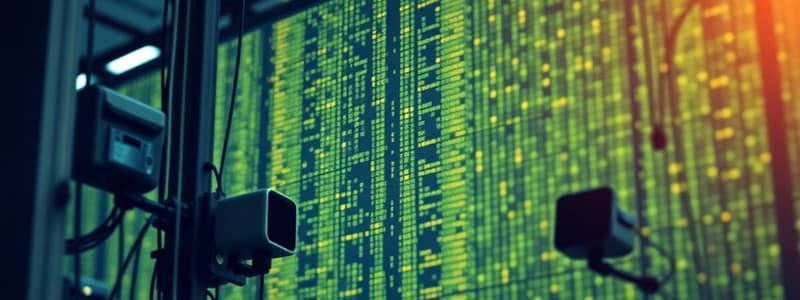Podcast
Questions and Answers
What is communication?
What is communication?
The basic process of exchanging information from one location to another.
Match the components of a communication system with their descriptions:
Match the components of a communication system with their descriptions:
Transmitter = Prepares data to be sent Receiver = Receives and processes the transmitted data Channel = Medium through which the data is transmitted
What is the role of a source encoder?
What is the role of a source encoder?
- Receives the transmitted data
- Adds extra bits to the signal
- Converts digital to analog signals
- Maps the signal produced by the source into a digital form (correct)
Noise is a desired effect in communication systems.
Noise is a desired effect in communication systems.
What is the purpose of modulation?
What is the purpose of modulation?
Which of the following is NOT a source of problems in communication systems?
Which of the following is NOT a source of problems in communication systems?
The communication system component that generates messages is called the ______.
The communication system component that generates messages is called the ______.
What factors give rise to the need for different types of communication systems?
What factors give rise to the need for different types of communication systems?
What is the main focus of a channel encoder?
What is the main focus of a channel encoder?
What are the three basic components of a communication system?
What are the three basic components of a communication system?
What function does the source encoder perform?
What function does the source encoder perform?
Which of the following describes the role of the transmitter in a communication system?
Which of the following describes the role of the transmitter in a communication system?
What is true about the communication channel in a communication system?
What is true about the communication channel in a communication system?
What type of signal does a source encoder typically handle?
What type of signal does a source encoder typically handle?
What is a primary purpose of a channel encoder?
What is a primary purpose of a channel encoder?
In a communication system, which component is responsible for processing the received signal?
In a communication system, which component is responsible for processing the received signal?
What is the role of a transducer in a communication system?
What is the role of a transducer in a communication system?
Which of the following describes the process of modulation?
Which of the following describes the process of modulation?
What is the primary purpose of adding redundancy in binary data transmission?
What is the primary purpose of adding redundancy in binary data transmission?
Which of the following is NOT one of the main sources of problems that communication systems face?
Which of the following is NOT one of the main sources of problems that communication systems face?
What distinguishes data from a signal in a communication system?
What distinguishes data from a signal in a communication system?
Which factor contributes to the need for various types of communication systems?
Which factor contributes to the need for various types of communication systems?
Which option best defines interference in communication systems?
Which option best defines interference in communication systems?
What is a primary characteristic of jamming in communication systems?
What is a primary characteristic of jamming in communication systems?
What is the role of a channel encoder during data transmission?
What is the role of a channel encoder during data transmission?
What characterizes a continuous signal?
What characterizes a continuous signal?
Which type of data and signal combination is exemplified by Voice over IP (VoIP)?
Which type of data and signal combination is exemplified by Voice over IP (VoIP)?
What does the amplitude of a sine wave represent?
What does the amplitude of a sine wave represent?
Which of the following is NOT a characteristic of a square wave?
Which of the following is NOT a characteristic of a square wave?
In the context of signal representation, what does frequency refer to?
In the context of signal representation, what does frequency refer to?
Which characteristic distinguishes discrete signals from continuous signals?
Which characteristic distinguishes discrete signals from continuous signals?
What type of network uses Digital Data, Digital Signal?
What type of network uses Digital Data, Digital Signal?
Which statement about analog data and digital signals is incorrect?
Which statement about analog data and digital signals is incorrect?
Flashcards
Communication System
Communication System
A system for exchanging information from a source to a destination, involving a transmitter, channel, and receiver.
Transmitter
Transmitter
The component of a communication system that prepares data for transmission over a channel.
Receiver
Receiver
The component of a communication system that receives and interprets data.
Communication Channel
Communication Channel
Signup and view all the flashcards
Information Source
Information Source
Signup and view all the flashcards
Source Encoder/Decoder
Source Encoder/Decoder
Signup and view all the flashcards
Channel Encoder/Decoder
Channel Encoder/Decoder
Signup and view all the flashcards
Modulation
Modulation
Signup and view all the flashcards
Noise
Noise
Signup and view all the flashcards
Data vs. Signal
Data vs. Signal
Signup and view all the flashcards
Communication Systems
Communication Systems
Signup and view all the flashcards
Transmitter
Transmitter
Signup and view all the flashcards
Receiver
Receiver
Signup and view all the flashcards
Source Encoder
Source Encoder
Signup and view all the flashcards
Source Signals
Source Signals
Signup and view all the flashcards
Channel Encoder
Channel Encoder
Signup and view all the flashcards
Communication Channel
Communication Channel
Signup and view all the flashcards
Information Source
Information Source
Signup and view all the flashcards
Channel Encoder
Channel Encoder
Signup and view all the flashcards
Modulation
Modulation
Signup and view all the flashcards
Noise
Noise
Signup and view all the flashcards
Interference
Interference
Signup and view all the flashcards
Jamming
Jamming
Signup and view all the flashcards
Data
Data
Signup and view all the flashcards
Signal
Signal
Signup and view all the flashcards
Communication Channel
Communication Channel
Signup and view all the flashcards
Analog Data
Analog Data
Signup and view all the flashcards
Digital Data
Digital Data
Signup and view all the flashcards
Analog Signal
Analog Signal
Signup and view all the flashcards
Digital Signal
Digital Signal
Signup and view all the flashcards
Continuous Signal
Continuous Signal
Signup and view all the flashcards
Discrete Signal
Discrete Signal
Signup and view all the flashcards
Sine Wave
Sine Wave
Signup and view all the flashcards
Square Wave
Square Wave
Signup and view all the flashcards
Study Notes
Course Information
- Course Title: Communication Technology
- Course Code: IT438
- Instructor: Kamal Hamza, PhD
- Semester: Fall 2024-2025
- University: The Egyptian E-Learning University (EELU)
- Acknowledgment: Presentation contains information from Data Communications and Networks by W. Stallings.
Introduction
- Communication: The process of exchanging information from a source to a destination.
- Includes sending, receiving, and processing information/signals.
Communication System Components
- Basic Blocks: Transmitter, Receiver, and Communication Channel.
- Transmitter: Prepares data for transmission in a suitable format.
- Source: Provides the data or information.
- Channel: Medium for transmission.
- Receiver: Receives and interprets the transmitted signal.
- Recipient: Destination of the information.
Communication System Components (cont.)
- Information Source: Generates the message (e.g., voice, image, keyboard input).
- Transducer: Converts non-electrical messages to electrical signals.
- Source can be analog or digital.
Source Encoder/Decoder
- Source Encoder: Maps signal into digital form and removes redundancy.
- Mapping: Allows efficient representation using fewest bits possible.
- Inverse operation (decoding) is achievable.
- Example: Converting analog voice to digital form (MP3 compression).
Channel Encoder/Decoder
- Maps input signal for noise reduction.
- Adds redundancy for error detection and correction.
- Improves reliable transmission over noisy channels.
Modulator
- Modulates signals for efficient channel transmission.
- Modifies amplitude, phase, or frequency of a carrier signal.
Examples of Guided Communication Channels
- Twisted Pair: Separately insulated, twisted wires, often bundled. Common in buildings.
- Coaxial Cable: Inner conductor, outer conductor with insulation, used in some applications.
- Optical Fiber: Glass or plastic core for light transmission.
Examples of Unguided Communication Channels
- Microwaves
- Satellites
- Radio Waves
- Infrared
Why Different Types of Communication Systems?
- Communication channel type (e.g., underwater needs fiber optic).
- Application needs (e.g., mobile apps need wireless).
- Signal quality requirements.
- Cost
Problems Facing Communication Systems
- Noise: Undesired signal from the environment.
- Interference: Resulting from overlapping signals (e.g., voice interference).
- Jamming: Deliberate interference to disrupt communication.
Data vs Signal
- Data = information to be transmitted.
- Signal = representation of data, transmitted over a channel.
- Example: speaking into a microphone, data is the spoken words, signal is the electrical waves.
Types of Data and Signals
- Analog Data/Analog Signal: Traditional phone systems.
- Analog Data/Digital Signal: Voice over IP (VoIP).
- Digital Data/Analog Signal: Early internet modems.
- Digital Data/Digital Signal: Modern computer networks (Ethernet, Wi-Fi).
Signal Representation in the Time Domain
- Continuous Signal: Signal intensity smoothly varies over time.
- Discrete Signal: Signal intensity maintains constant levels for periods then changes.
- Examples: Sine wave, square wave.
Signal Representation in the Time Domain (cont.)
- Sine Wave: Smooth, periodic oscillation, described by amplitude, frequency, and phase.
- Square Wave: Rapidly switches between high and low values; used to represent digital data.
- Representing Signals by Time Domain.
Signal Representation in the Time Domain (cont.)
- Period (T): Time to complete one full cycle of a wave (inverse of frequency).
- Phase: Horizontal shift in a wave. Phase differences are important in modulation.
- Sine Wave Equation: s(t) = A sin(2πft + φ).
- Amplitude, frequency, and phase describe the sine wave's characteristics, using the equation.
Studying That Suits You
Use AI to generate personalized quizzes and flashcards to suit your learning preferences.




